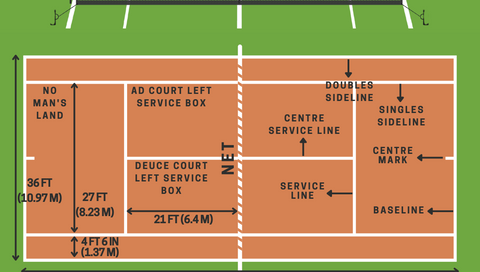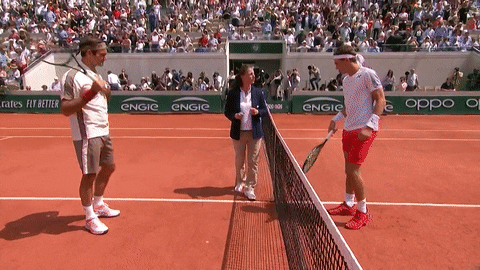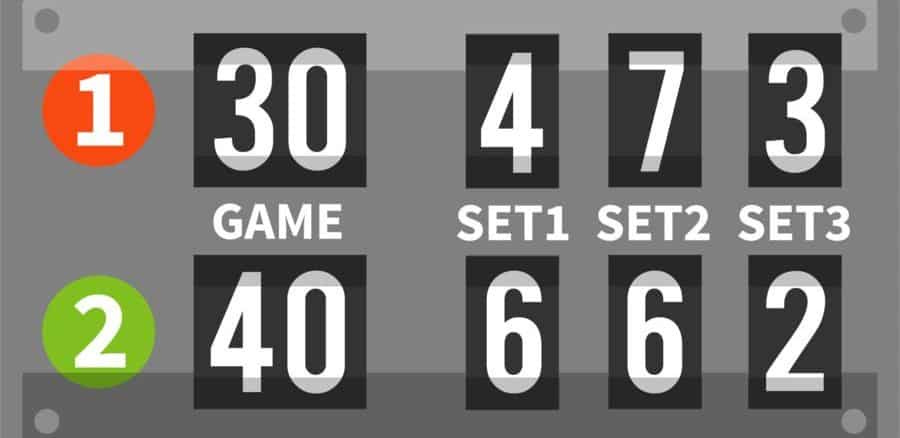The Basics of Tennis: Court, Rules, and Match Instructions.
Learn the fundamentals of tennis with this easy-to-follow guide, perfect for players and fans alike.
Tennis is a beautiful sport that offers something for everyone—whether you’re stepping onto the court for the first time or simply enjoying the thrill of watching a match. At NetNova Academy, our mission is to provide tennis content that helps you improve your game or deepen your appreciation for the sport in a way that’s easy and enjoyable.
To truly enjoy playing or watching tennis, it’s essential to understand how it works. This post is designed to guide you through the basics of tennis, from the layout of the court to the rules of the game. Whether you’re a beginner or a curious spectator, we’ll make it simple and engaging for you. Let’s get started!
1. Court Dimensions
Understanding the tennis court layout is the first step to mastering the game.
Length: The court measures 23.77 meters (78 feet) in total, from baseline to baseline. Each half, divided by the net, is 11.89 meters (39 feet) long.
Width: The singles court is 8.23 meters (27 feet) wide, while the doubles court includes the alleys, making it 10.97 meters (36 feet) wide.
Net Height: The net stands at 0.91 meters (3 feet) at the center and 1.07 meters (3.5 feet) at the posts.
Service Boxes: Each half is divided into two service boxes, each measuring 6.40 meters (21 feet) long and 4.11 meters (13.5 feet) wide. Players must aim their serves diagonally into their opponent’s corresponding service box.
Baseline and Sidelines: These lines mark the boundaries for singles and doubles matches.
2. Basic Rules of a Tennis Match
Starting the Match
In professional tournaments, the decision of who serves first and which side to start on is determined by an official coin toss or racket spin, conducted by the chair umpire. The winner chooses whether to serve, receive, or select the side of the court.
In casual matches, players can decide who starts by tossing a coin, spinning a racket, or any agreed-upon method. Fairness and mutual agreement are key.
Scoring System
Points: Tennis uses a unique scoring system: 0 (Love), 15, 30, 40, and Game. Players need to win at least four points to win a game, with a margin of two points.
Games: A set consists of at least six games. To win a set, a player must lead by two games (e.g., 6-4 or 7-5). If the score reaches 6-6, a tiebreaker is played.
Sets: Matches are typically the best of three sets for both men and women. However, in Grand Slam tournaments, men’s singles matches are the best of five sets, while women’s singles and doubles remain best of three.
Serving
Players serve from behind the baseline, alternating sides for each point (starting on the right).
The serve must land in the diagonal service box.
Each player has two chances to serve. A missed serve is called a fault, and two consecutive faults result in a double fault, awarding the point to the opponent.
Winning Points
You win a point if:
Your opponent cannot return the ball within the court boundaries.
The ball bounces more than once on your opponent’s side.
Your opponent hits the ball into the net or out of bounds.
Change of Sides
Players switch sides of the court every odd-numbered game (e.g., after the 1st, 3rd, 5th game).
Let Serve
If the ball hits the net during a serve but still lands in the correct service box, it is called a let, and the serve is replayed.
3. Tiebreaker Rules
Tiebreakers are a thrilling way to resolve a set when the score reaches 6-6. Here's how a classical tiebreaker works:
Classical Tiebreaker Rules
First Serve: The player who was due to serve at 6-6 serves the first point of the tiebreak from the deuce court (right side).
Alternating Serves: After the first point, the serve alternates every two points.
Scoring: The tiebreak is scored numerically (1, 2, 3…).
Winning the Tiebreak: The first player to reach 7 points with a 2-point lead wins.
Changing Ends: Players switch sides every 6 points (e.g., at 3-3 or 6-6).
4. Tiebreaker Rules in Grand Slam Matches
While classical tiebreakers are common, Grand Slam tournaments have specific rules for the final set, which vary by event.
Australian Open: A super tiebreaker is played at 6-6 in the final set. The first to 10 points with a 2-point lead wins.
French Open: There’s no tiebreaker; players must win by two games, leading to marathon matches.
Wimbledon: A standard tiebreaker is played at 12-12 in the final set.
US Open: A standard tiebreaker occurs at 6-6, just like in earlier sets.
Understanding the Rule with a Scenario
Imagine you’re playing a match in the final set of a Grand Slam, and the score is tied at 4-4. You and your opponent each win two more games, making it 6-6. What happens next depends on the tournament:
If it’s the US Open, you’ll immediately play a standard tiebreaker to decide the winner of the set and the match.
At the Australian Open, you’ll play a super tiebreaker (first to 10 points).
At Wimbledon, you’ll continue playing until 12-12, then enter a standard tiebreaker.
At the French Open, you’ll need to win at least two consecutive games to claim victory, meaning the set could theoretically go on indefinitely.
This variation in rules explains why matches like the famous John Isner vs. Nicolas Mahut at Wimbledon 2010 (ending at 70-68 in the final set) were possible. It’s also why tournaments have since updated their rules to include tiebreakers in the final set.
Deuce and Advantage
At 40-40, the score is called deuce.
The player who wins the next point gains advantage. If they win the following point, they win the game. If they lose, the score returns to deuce.
Doubles Rules
Doubles matches use the wider court dimensions (including the alleys).
Partners alternate serves and decide who receives on each side.
5. Special Rules and Variations
Let Rule Variations
Some tournaments, especially in juniors or smaller circuits, allow a serve that clips the net and lands in the correct service box (a let) to count as a valid serve. A memorable moment occurred when Novak Djokovic played Nick Kyrgios in an exhibition match. Djokovic forgot the rule and stopped playing, giving Kyrgios the point and amusing the crowd.
No-Ad Scoring
In some tournaments or doubles matches, a no-advantage rule is used. At deuce, the next point decides the game, speeding up play.
6. Tips for Beginners
Always call the score before each serve to keep everyone on the same page.
Practice your serve—it’s the only shot you have complete control over.
Respect your opponent by retrieving balls quickly and staying quiet during rallies.
Final Thoughts
Tennis may seem complex at first, but with an understanding of the basics, it becomes an exhilarating and rewarding game. By learning the court dimensions, scoring system, and rules, you’ll be ready to enjoy tennis as a player or spectator. Whether you’re picking up a racket or watching from the stands, tennis offers something for everyone.
Support NetNova Academy
If you enjoyed this post and found it helpful, consider subscribing to NetNova Academy for more tennis insights, tips, and guides. We’re dedicated to making tennis accessible and enjoyable for everyone.
If you’d like to support our work, you can also buy us a coffee! Your contributions help us keep creating quality tennis content for free.
Thank you for being part of our community! Let’s keep improving together. 🎾











Love this! It summaries how tennis works very simply and engaging!